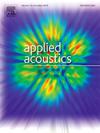Range-dimensional frequency band extension hyper beamforming
IF 3.4
2区 物理与天体物理
Q1 ACOUSTICS
引用次数: 0
Abstract
Range estimation is crucial in sonar systems. To enhance range detection capability of active sonar, we propose a range-dimensional frequency band extension hyper beamforming method that improves range resolution and sidelobe suppression performance. The received signal's band is divided into narrowband frequency points. The phase shifts of these frequency points induced by the target distance form a geometric series. A bidirectional linear prediction (LP)-based virtual frequency band extension method exploits phase shift correlations to generate the predicted band. By expanding signal bandwidth, range resolution is preliminarily improved. After extension, the frequency band is divided into two half-bandwidth sub-bands for scanning at different ranges to obtain the beamforming outputs. A “sum” beam is formed by summing the magnitudes of the two sub-band beams, while a “difference” beam is obtained by taking the magnitude of their difference. At the target distance, the “sum” beam reaches its maximum, while the “difference” beam reaches its minimum, both sharing the same sidelobe locations. The hyper beam exponent is chosen to exponentiate the “sum” and “difference” beams, adjusting their contribution weights in the calculation. By amplitude cancellation, the range-dimensional output is optimized. Through nonlinear processing, a range-dimensional power spectrum with low sidelobes and a narrowed main lobe is obtained. Furthermore, we present a fast implementation using complex operations, fast Fourier transform (FFT), and inverse fast Fourier transform (IFFT), improving computational efficiency. Simulations demonstrate the proposed method delivers excellent range resolution and sidelobe suppression capability, while dynamic and static experimental data further validate the effectiveness.
距离维频带扩展超波束形成
距离估计在声纳系统中是至关重要的。为了提高主动声呐的距离探测能力,提出了一种距离维频带扩展超波束形成方法,提高了距离分辨率和旁瓣抑制性能。接收信号的频带被划分为窄带频率点。这些频点的相移由目标距离引起,形成一个几何级数。一种基于双向线性预测(LP)的虚拟频带扩展方法利用相移相关产生预测频带。通过扩大信号带宽,初步提高了距离分辨率。扩展后的频带分为两个半带宽子频带,分别在不同距离上进行扫描,得到波束形成输出。将两个子带光束的幅值相加形成“和”光束,而取其差值的幅值得到“差”光束。在目标距离处,“和”波束达到最大值,“差”波束达到最小值,两者共享相同的副瓣位置。选择超光束指数对“和”和“差”光束取幂,调整其在计算中的贡献权重。通过幅度对消,优化了距离维输出。通过非线性处理,得到了具有低副瓣和窄主瓣的范围维功率谱。此外,我们提出了一种使用复杂运算、快速傅立叶变换(FFT)和反快速傅立叶变换(IFFT)的快速实现,提高了计算效率。仿真结果表明,该方法具有良好的距离分辨率和旁瓣抑制能力,动态和静态实验数据进一步验证了该方法的有效性。
本文章由计算机程序翻译,如有差异,请以英文原文为准。
求助全文
约1分钟内获得全文
求助全文
来源期刊

Applied Acoustics
物理-声学
CiteScore
7.40
自引率
11.80%
发文量
618
审稿时长
7.5 months
期刊介绍:
Since its launch in 1968, Applied Acoustics has been publishing high quality research papers providing state-of-the-art coverage of research findings for engineers and scientists involved in applications of acoustics in the widest sense.
Applied Acoustics looks not only at recent developments in the understanding of acoustics but also at ways of exploiting that understanding. The Journal aims to encourage the exchange of practical experience through publication and in so doing creates a fund of technological information that can be used for solving related problems. The presentation of information in graphical or tabular form is especially encouraged. If a report of a mathematical development is a necessary part of a paper it is important to ensure that it is there only as an integral part of a practical solution to a problem and is supported by data. Applied Acoustics encourages the exchange of practical experience in the following ways: • Complete Papers • Short Technical Notes • Review Articles; and thereby provides a wealth of technological information that can be used to solve related problems.
Manuscripts that address all fields of applications of acoustics ranging from medicine and NDT to the environment and buildings are welcome.
 求助内容:
求助内容: 应助结果提醒方式:
应助结果提醒方式:


